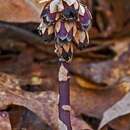Comprehensive Description
(
Inglês
)
fornecido por North American Flora
Monotropsis odorata Ell. Bot. S. C. & Ga. 1: 479. 1817
Schweinitzia odorata Raf. Am. Mo. Mag. 3: 99. 1818. Schweinitzia caroliniana G. Don, Gen. Hist. 3: 867. 1834.
Plants 51 1 cm. tall, the stems usually clustered, purple or pmplish-brown ; leaves mostly 3-8 mm. long, the blades deltoid-ovate to ovate, obtuse or acute; flowers violet-scented; sepals oblong to oblong-lanceolate, 8-12 mm. long, mostly acute or acutish, membranous in age ; corolla pink, about equal to the calyx in length, the lobes ovate, much shorter than the tube.
Type IvOCALITy: Stokes County, North Carolina. Distribution: Maryland to Kentucky, Georgia, and Alabama.
- citação bibliográfica
- John Kunkel Small, NathanieI Lord Britton, Per Axel Rydberg, LeRoy Abrams. 1914. ERICALES, CLETHRACEAE, LENNOACEAE, PTROLACEAE, MONOTROPACEAE, ERICACEAE, UVA-URSI. North American flora. vol 29(1). New York Botanical Garden, New York, NY
Comprehensive Description
(
Inglês
)
fornecido por North American Flora
Monotropsis reynoldsiae (A. Gray) A. Heller, Cat. N. Am
PL 5. 1898.
Schweinitzia Reynoldsiae A. Gray, Proc. Am. Acad. 20: 301. 1885.
Plants more slender than the two preceding species, 4-13 cm. tall, the stems often clustered, purple; leaves mostly 2-6 mm. long, the blades ovate or ovate-lanceolate, acute or short-acuminate; flowers more or less fragrant; sepals ovate or ovate-lanceolate or rarely linear, 2-4 mm. long, mostly acutish, often erose near the apex, membranous in age; corolla white, much longer than the calyx, the lobes ovate, much shorter than the tube.
Type locality: Near St. Augustine, Florida, Distribution: Eastern Florida and the Indian River region.
- citação bibliográfica
- John Kunkel Small, NathanieI Lord Britton, Per Axel Rydberg, LeRoy Abrams. 1914. ERICALES, CLETHRACEAE, LENNOACEAE, PTROLACEAE, MONOTROPACEAE, ERICACEAE, UVA-URSI. North American flora. vol 29(1). New York Botanical Garden, New York, NY
Comprehensive Description
(
Inglês
)
fornecido por North American Flora
Monotropsis lehmaniae Burnham, Torreya 6: 235. 1906
Plants 4-10 cm. tall, the stems mainly brownish-purple; leaves mostly 2-6 mm. long, the blades ovate, often very broadly so at the base of the stem, obtuse or acute; flowers not fragrant; sepals narrowly oblong to linear-oblong or oblong-lanceolate, 7-8 mm. long, or slightly broadened upward, mostly obtuse or obtusish, membranous in age; corolla mainly pink, much shorter than the calyx, the lobes as long as the tube or nearly so.
Typb i<ocal,ity: Roaring Gap, Blue Ridge, North Carolina. Distribution : Western North Carolina.
- citação bibliográfica
- John Kunkel Small, NathanieI Lord Britton, Per Axel Rydberg, LeRoy Abrams. 1914. ERICALES, CLETHRACEAE, LENNOACEAE, PTROLACEAE, MONOTROPACEAE, ERICACEAE, UVA-URSI. North American flora. vol 29(1). New York Botanical Garden, New York, NY
Monotropsis odorata
(
Alemão
)
fornecido por wikipedia DE
Monotropsis odorata ist eine Pflanzenart aus der Familie der Heidekrautgewächse (Ericaceae) und die einzige Art ihrer Gattung.
Beschreibung
Monotropsis odorata ist eine chlorophylllose, myko-heterotrophe krautige Pflanze. Ihre Wurzeln sind korallenförmig, die aus ihnen sprießende Spross- und Blütenstandsachse steht nickend und ist purpurn bis violett. Die Blätter sind einfach, Vorblätter fehlen.
Der Blütenstand ist mehrblütig. Die Blüten sind fünf-, selten vier- bis sechszählig, Kelchblätter sind vorhanden und anhand der Textur unterscheidbar. Die Krone ist annähernd röhrenförmig, die Kronblätter sind miteinander verwachsen und am Ansatz schwach sackförmig. Die Staubblätter sind rund drei Fünftel so lang wie die Krone, die Poren der Staubbeutel sind nach außen gewandt, die Nektarien sind gekerbt. Der Griffel ist dauernd, die Narbe erweitert.
Der Fruchtknoten weist weitgehend parietale Plazentation auf. Die Frucht ist beerenartig, die Samen sind eiförmig und dickhäutig.
Die Samen sind linealisch, dünnwandig und haben längliche Zellen.
Die Chromosomenzahl beträgt n=13.
Verbreitung
Die Art findet sich im Südosten der USA in Alabama, Delaware, Florida, Georgia, Kentucky, North Carolina, South Carolina, Tennessee und Virginia in Höhenlagen zwischen 600 und 1350 Metern.[1]
Systematik
Art und Gattung wurden 1817 durch Ludwig David von Schweinitz erstbeschrieben.
Literatur
- P. F. Stevens et al.: Ericaceae. In: Klaus Kubitzki (Hrsg.): The Families and Genera of Vascular Plants - Volume VI - Flowering Plants - Dicotyledons - Celastrales, Oxalidales, Rosales, Cornales, Ericales. 2004, ISBN 978-3-540-06512-8, S. 167–168.
Einzelnachweise
-
↑ Gary D. Wallace: Monotropsis Schweinitz. In: Flora of North America, vol. 8. [1].
- licença
- cc-by-sa-3.0
- direitos autorais
- Autoren und Herausgeber von Wikipedia
Monotropsis odorata: Brief Summary
(
Alemão
)
fornecido por wikipedia DE
Monotropsis odorata ist eine Pflanzenart aus der Familie der Heidekrautgewächse (Ericaceae) und die einzige Art ihrer Gattung.
- licença
- cc-by-sa-3.0
- direitos autorais
- Autoren und Herausgeber von Wikipedia

